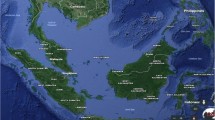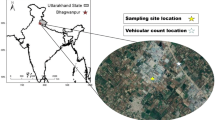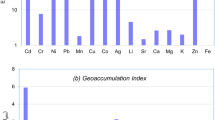Abstract
This paper investigates the chemical composition of Particulate Matter, Organic Carbon (OC), and Elemental Carbon (EC) in residential and traffic sites in Mumbai. The average PM2.5 and PM10 concentrations at the traffic site (Sakinaka) were 240 µg/m3 and 424 µg/m3, respectively. The observed levels of OC were 35 µg/m3, 22 µg/m3, and 15.5 µg/m3 at Sakinaka junction (high-density traffic), YP-Gate (low-density traffic), and Hostel Premise (Residential), respectively. The average OC/EC ratio value was high (4.5) at the residential site, indicating contributions from stationary combustion sources and secondary production of carbonaceous species to OC. The residential site has a higher percentage of low volatile OC fraction (57%) in total OC than the traffic sites. On the other hand, Sakinaka has a higher percentage of highly volatile OC fractions (36%) in total OC. The crustal-originated metals were dominating in all areas, but the concentration of metals from anthropogenic sources was highest at Sakinaka, i.e., As (381 ng/m3), Pb (352 ng/m3), Zn (679 ng/m3). The K/Al, Ca/Al, Mg/Al, and Fe/Al ratios were high in all the samples compared to the crustal ratio indicating biomass burning and traffic emission sources of these metals. PM originating from traffic was more enriched with heavy metals that are toxic to human health, increasing cancer risks (CR) through inhalation. The hazard quotient was above 1 at all the locations, and CR was above 1 × 10− 4, causing health risks. According to the dosimetry model, more PM was deposited in the lungs of traffic location occupants through inhalation, increasing the cancerous risk.

(Source: Google Earth Pro and MERRA reanalysis data Giovanni and unit of organic carbon is kg/m3)





Similar content being viewed by others
Data availability
The datasets generated during and analyzed during the current study are not publicly available but are available from the corresponding author at a reasonable request.
References
5-deadliest traffic junctions in Mumbai. https://blog.driveu.in/5-deadliest-traffic-junctions-in-mumbai-85e66c4b0b3b. Accessed 01 Oct 2021
Air resource laboratory-Hysplit. https://www.ready.noaa.gov/HYSPLIT.php (2022). Accessed 18 Jul 2022
AQI. https://www.aqi.in/world-most-polluted-cities (2022). Accessed 10 Apr 2022
Araujo, J.A., Andre, E.N.: Particle and Fibre Toxicology Particulate Matter and atherosclerosis: Role of particle size, composition and oxidative stress. (2009). http://www.particleandfibretoxicology.com/content/6/1/24
Aslam, A., et al.: Pollution characteristics of Particulate Matter (PM2.5 and PM10) and Constituent Carbonaceous Aerosols in a south Asian future megacity. Appl. Sci. (Switzerland) 10(24), 1–17 (2020)
Birch, M., Eileen: Analysis of Carbonaceous Aerosols: Interlaboratory comparison. Analyst 123(5), 851–857 (1998)
Bolognin, S., et al.: Metal Ion Physiopathology in Neurodegenerative Disorders. (2009)
Cao, J.J., et al.: Characterization of Roadside Fine Particulate Carbon and its eight fractions in Hong Kong. Aerosol Air Qual. Res. 6(2), 106–122 (2006)
Central Pollution Control Board. https://www.cpcb.nic.in (2022). Accessed 20 Apr 2022
Chakraborty, A., Tripathi, S.N., Gupta, T.: Effects of Organic Aerosol Loading and Fog Processing on Organic Aerosol Volatility. J. Aerosol Sci. 105(November 2016), 73–83 (2017). https://doi.org/10.1016/j.jaerosci.2016.11.015
Chauhan, A.: Effect of lockdown on HCHO and trace gases over India during March 2020. Aerosol Air Qual. Res. 21(4), 1–19 (2021)
Chow, J.C., et al.: Source profiles for industrial, mobile, and area sources in the Big Bend Regional Aerosol visibility and observational study. Chemosphere 54(2), 185–208 (2004)
Chowdhury, Z., et al.: Speciation of ambient fine Organic Carbon particles and source apportionment of PM2.5 in indian cities. J. Geophys. Res. Atmos 112(15), 1–14 (2007)
Dongarrà, G., Manno, E., Varrica, D., Vultaggio, M.: Mass levels, crustal component and trace elements in PM10 in Palermo, Italy. Atmos. Environ 41(36), 7977–7986 (2007)
Douglas, P., et al.: A systematic review of the Public Health Risks of Bioaerosols from Intensive Farming. Int. J. Hyg. Environ Health 221(2), 134–173 (2018)
Engelbrecht, J.P., et al.: Technical note: Mineralogical, chemical, morphological, and optical interrelationships of mineral dust resuspensions. Atmos. Chem. Phys 16(17), 10809–10830 (2016). (14 Sept 2022)
Gao, Y., et al.: Characterization of Atmospheric Trace Elements on PM2.5 particulate matter over the New York–New Jersey Harbor Estuary. Atmos. Environ. 36(6), 1077–1086 (2002)
Han, Y., et al.: Evaluation of the Thermal/Optical Reflectance Method for discrimination between Char- and Soot-EC. Chemosphere 69(4), 569–574 (2007)
Han, Y.M., et al.: Elemental Carbon in Urban Soils and Road Dusts in Xi’an, China and its implication for Air Pollution. Atmos. Environ. 43(15), 2464–2470 (2009)
Han, Y.M., et al.: Different characteristics of char and soot in the atmosphere and their ratio as an indicator for source identification in Xi’an, China. Atmos. Chem. Phys. 10(2), 595–607. (2010). https://acp.copernicus.org/articles/10/595/2010/ (14 Sep 2022)
Hans Wedepohl, K.: The composition of the Continental Crust. Geochim. Cosmochim. Acta 59(7), 1217–1232 (1995)
Hildemann, L.M., Gregory, R., Markowski, Glen, R.C.: 25 In Onondaga County Monitoring Program Annual Report Heavy Metal Distribution in Particles from the Flocculent Sediments of Onondaga Lake. Wiley and Sons. (1991). https://pubs.acs.org/sharingguidelines
Im, U., et al.: Evaluation of operational online-coupled Regional Air Quality Models over Europe and North America in the context of AQMEII phase 2. Part II: Particulate matter. Atmos. Environ. 115, 421–441 (2015)
IQAir. https://www.iqair.com/in-en/. Accessed 10 Apr 2022
Jack, S.S., et al.: Pollution characteristics and chronic health risk assessment of metals and metalloids in ambient PM 2.5 in Licheng District, Jinan, China. Environ. Geochem. Health 42 (2020). https://doi.org/10.1007/s10653-019-00448-7
Jacobson, M.Z.: Strong radiative heating due to mixing state of black carbon in atmospheric aerosol. Mixing State of Black Carbon in Atmospheric Aerosols. 409(January 2001), 695–97 (2016)
Jamhari, A.A., et al.: Seasonal variation and size distribution of Inorganic and Carbonaceous Components, source identification of size-fractioned Urban Air particles in Kuala Lumpur, Malaysia. Chemosphere 287, 132309 (2022)
Joseph, A., Elizabeth, S., Unnikrishnan: Chemical characterization and Mass Closure of Fine Aerosol for different land use patterns in Mumbai City. Aerosol Air Qual. Res. 12(1), 61–72 (2012)
Kim, E., Hopke, P.K.: Improving source identification of Atlanta Aerosol using temperature resolved Carbon fractions in positive Matrix Factorization. Atmos. Environ. 38(20), 3349–3362 (2004)
Kirkevåg, A., et al.: Aerosol–climate interactions in the norwegian Earth System model – NorESM1-M. Geosci. Model Dev. 6(1), 207–244 (2013). ((November 8, 2022))
Kroll, J.H.: Chemistry of secondary Organic Aerosol: Formation and evolution of low-volatility Organics in the atmosphere. Atmos. Environ. 42(16), 3593–3624 (2008)
Kumar, S., Nath, S., Bhatti, M.S., Yadav, S.: Chemical characteristics of fine and coarse particles during Wintertime over two Urban Cities in North India. Aerosol Air Qual. Res. 18(7), 1573–1590 (2018)
Lee, P.K.H., Brook, J.R., Dabek-Zlotorzynska, E., Mabury, S.A.: Identification of the major sources contributing to PM2.5 observed in Toronto. Environmen Sci Technol. 37(21), 4831–4840 (2003). https://doi.org/10.1021/es026473i
Li, H., et al.: Chemical characterization and source apportionment of PM2.5 aerosols in a megacity of Southeast China. Atmos. Res. 181, 288–299 (2016)
Lin, Y., Wang, J.: Concentrations, Enrichment, and sources of Metals in PM 2.5 in Beijing during Winter. (2020). https://doi.org/10.1007/s11869-019-00763-z
Liu, W., Wang, Y., Russell, A., Edgerton, E.S.: Enhanced source identification of southeast aerosols using temperature-resolved carbon fractions and gas phase components. Atmos Environ. 40(SUPPL. 2), 445–466 (2006). https://doi.org/10.1016/J.ATMOSENV.2005.11.079
Lv, H., et al.: Assessment of Pedestrian exposure and deposition of PM10, PM2.5 and Ultrafine particles at an urban Roadside: A case study of Xi’an, China. Atmos. Pollut.Res. 12(4), 112–121 (2021)
Manojkumar, N., Srimuruganandam, B.: Age-specific and seasonal deposition of outdoor and indoor particulate matter in human respiratory tract. Atmos Pollut Res. 13(2) (2022). https://doi.org/10.1016/j.apr.2021.101298
Mclennan, S.M.: Relationships between the Trace Element Composition of Sedimentary Rocks and Upper Continental Crust. (2001)
Mehra, M., Zirzow, F., Ram, K.: Geochemistry of PM2.5 aerosols at an urban site, Varanasi, in the Eastern Indo-Gangetic Plain during Pre-Monsoon season. Atmos. Res. 234, 104734 (2020)
Menache, M.: Particle inhalability curves for humans and small Laboratory Animals. Ann. Occup. Hyg. 39(3), 317–328 (1995)
Merra reanalysis data. https://gmao.gsfc.nasa.gov/reanalysis/MERRA-2 (2022). Accessed 15 Jun 2022
Multiple-Path Particle Dosimetry Model (MPPD). https://www.ara.com/mppd/ (2022). Accessed 20 Aug 2022
Pachauri, T., et al.: Characteristics and sources of Carbonaceous Aerosols in PM2.5 during Wintertime in Agra, India. Aerosol Air Qual. Res. 13(3), 977–991 (2013)
Rastogi, N., Singh, A., Sarin, M.M., Singh, D.: Temporal variability of primary and secondary aerosols over Northern India: Impact of Biomass Burning Emissions. Atmos. Environ. 125, 396–403 (2016). https://doi.org/10.1016/j.atmosenv.2015.06.010
Reddy, M., Shekar: Inventory of Aerosol and Sulphur Dioxide Emissions from India. Part II—Biomass Combustion. Atmos. Environ. 36(4), 699–712 (2002)
Rengarajan, R., Sarin, M.M., Sudheer, A.K.: Carbonaceous and inorganic Species in Atmospheric Aerosols during Wintertime over Urban and High-Altitude Sites in North India. J. Geophys. Res. Atmos. 112(21), 1–16 (2007)
Rudnick, R.L.: Rutile-Bearing Refractory Eclogites: Missing link between continents and depleted Mantle. Science 287(5451), 278–281 (2000)
Saarikoski, S., et al.: Sources of organic carbon in fine particulate matter in Northern European urban air. Atmos. Chem. Phys. 8(20), 6281–6295 (2008)
Sah, D., Verma, P.K., Kandikonda, M.K.: Pollution characteristics, Human Health risk through multiple exposure pathways, and source apportionment of Heavy Metals in PM10 at Indo-Gangetic Site. Urban Clim. 27, 149–162 (2019)
Shen, Z., et al.: Chemical Profiles of urban fugitive Dust PM2.5 samples in Northern Chinese Cities. Sci. Total Environ. 569–570, 619–626 (2016)
SmartAIR. https://smartairfilters.com/en/blog/mumbai-air-quality-exceeds-8-times-who-limit-in-2021/ (2022). Accessed 10 Apr 2022
Soleimanian, E., et al.: Spatial Trends and sources of PM2.5 Organic Carbon volatility fractions (OCx) across the Los Angeles Basin. Atmos. Environ. 209, 201–211 (2019)
Sui, S., et al.: Pollution characteristics and Chronic Health Risk Assessment of Metals and Metalloids in ambient PM2.5 in Licheng District, Jinan, China. Environ. Geochem. Health 42(7), 1803–1815 (2020). https://doi.org/10.1007/s10653-019-00448-7
System of Air Quality and Weather Forecasting And Research (SAFAR). http://safar.tropmet.res.in/ (2022). Accessed 30 May 2022
Tomtom traffic index. https://www.tomtom.com (2021). Accessed 01 Nov 2021
Turpin, B.J.: Identification of secondary Organic aerosol episodes and quantitation of primary and secondary Organic aerosol concentrations during SCAQS. Atmos. Environ. 29(23), 3527–3544 (1995)
USEPA. https://www.epa.gov/expobox/exposure-factors-handbook-2011-edition (2011). Accessed 15 Apr 2022.
Wang, F., Feng, T., Guo, Z., Li, Y., Lin, T., Rose, N.L.: Sources and dry deposition of carbonaceous aerosols over the coastal East China Sea: Implications for anthropogenic pollutant pathways and deposition. Environ Pollut. 245, 771–779 (2019). https://doi.org/10.1016/J.ENVPOL.2018.11.059
WHO: WHO health report. https://www.who.int/about/accountability/results/2018-2019 (2018). Accessed 16 Apr 2022
WHO: WHO health report. https://apps.who.int/iris/handle/10665/107332 (2013). Accessed 10 Apr 2022
Xia, L.: Characterization of Trace Elements in PM2.5 Aerosols in the vicinity of highways in Northeast New Jersey in the U.S. East Coast. Atmos. Pollut. Res. 2(1), 34–44 (2011). https://doi.org/10.5094/APR.2011.005
Xing, W., et al.: Inhalation bioaccessibility of cd, Cu, Pb and Zn and Speciation of Pb in particulate matter fractions from areas with different pollution characteristics in Henan Province, China. Ecotoxicol. Environ. Saf. 175, 192–200 (2019)
Zhan, C., et al.: Characterization of carbonaceous fractions in PM2.5 and PM10 over a typical Industrial City in Central China. Environ. Sci. Pollut. Res. 26(17), 16855–16867 (2019)
Zhang, H., et al.: Source apportionment of PM2.5 nitrate and sulfate in China using a source-oriented Chemical Transport Model. Atmos. Environ. 62, 228–242 (2012)
Zhang, Q., et al.: Understanding Atmospheric Organic Aerosols via factor analysis of Aerosol Mass Spectrometry: A review. Anal. Bioanal. Chem. 401(10), 3045–3067 (2011)
Zwozdziak, A., et al.: Implications of the Aerosol size distribution Modal structure of Trace and Major elements on human exposure, inhaled dose and relevance to the PM2.5 and PM10 Metrics in a european Pollution Hotspot Urban Area. J. Aerosol. Sci. 103, 38–52 (2017)
Funding
The authors declare that no funds, grants, or other support were received during the preparation of this manuscript.
Author information
Authors and Affiliations
Contributions
Shruti Tripathi-Conceptualization; Data curation; Formal analysis; Methodology; and Writing original draft. Abhishek Chakraborty- Supervision, reviewed and edited. Debayan Mandal- Review and editing.
Corresponding author
Ethics declarations
Competing interests
The authors declare no competing interests.
Ethics approval
Not applicable.
Consent to participate
Not applicable.
Consent to publish
Not applicable.
Additional information
Publisher’s Note
Springer Nature remains neutral with regard to jurisdictional claims in published maps and institutional affiliations.
Electronic supplementary material
Below is the link to the electronic supplementary material.
Rights and permissions
Springer Nature or its licensor (e.g. a society or other partner) holds exclusive rights to this article under a publishing agreement with the author(s) or other rightsholder(s); author self-archiving of the accepted manuscript version of this article is solely governed by the terms of such publishing agreement and applicable law.
About this article
Cite this article
Tripathi, S., Chakraborty, A. & Mandal, D. Spatial variations in physico-chemical characteristics of PΜ2.5 in an urban coastal city of India and associated health risks. J Atmos Chem 80, 211–226 (2023). https://doi.org/10.1007/s10874-023-09448-5
Received:
Accepted:
Published:
Issue Date:
DOI: https://doi.org/10.1007/s10874-023-09448-5




